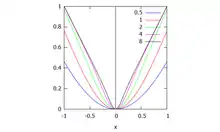Smooth maximum
In mathematics, a smooth maximum of an indexed family x1, ..., xn of numbers is a smooth approximation to the maximum function meaning a parametric family of functions such that for every α, the function is smooth, and the family converges to the maximum function as . The concept of smooth minimum is similarly defined. In many cases, a single family approximates both: maximum as the parameter goes to positive infinity, minimum as the parameter goes to negative infinity; in symbols, as and as . The term can also be used loosely for a specific smooth function that behaves similarly to a maximum, without necessarily being part of a parametrized family.
Examples

For large positive values of the parameter , the following formulation is a smooth, differentiable approximation of the maximum function. For negative values of the parameter that are large in absolute value, it approximates the minimum.
has the following properties:
- as
- is the arithmetic mean of its inputs
- as
The gradient of is closely related to softmax and is given by
This makes the softmax function useful for optimization techniques that use gradient descent.
LogSumExp
Another smooth maximum is LogSumExp:
This can also be normalized if the are all non-negative, yielding a function with domain and range :
The term corrects for the fact that by canceling out all but one zero exponential, and if all are zero.
Other choices of smoothing function
Where is a parameter.
See also
References
M. Lange, D. Zühlke, O. Holz, and T. Villmann, "Applications of lp-norms and their smooth approximations for gradient based learning vector quantization," in Proc. ESANN, Apr. 2014, pp. 271-276. (https://www.elen.ucl.ac.be/Proceedings/esann/esannpdf/es2014-153.pdf)